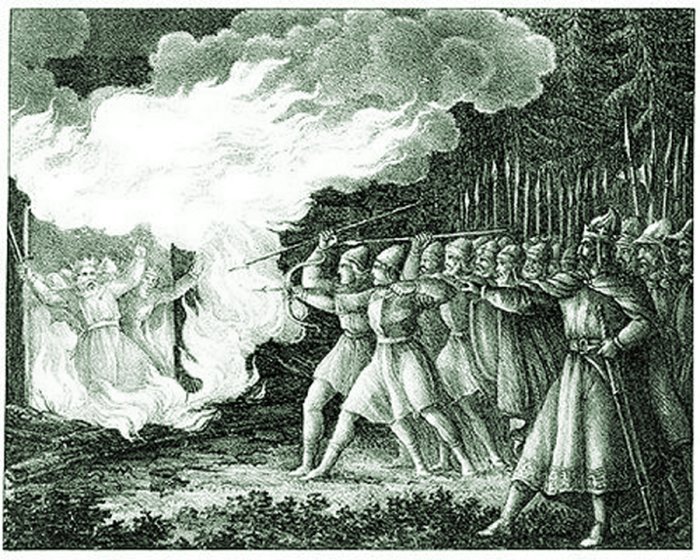Legendary Ynglings: Descendants Of The Norse Gods And Oldest Scandinavian King Dynasty
Norse legends tell the legendary Ynglings were descendants of the Norse gods and the oldest known Scandinavian King dynasty. In ancient times, they ruled as mighty kings in Sweden and Norway.
Their existence is still a subject shrouded in mystery. Did these people really exist? Historians are divided on this subject. Norwegians consider the Ynglings to be real historical figures, but in Sweden, the Ynglings have remained mythological characters.
It is difficult to get a better understanding of the Yngling King Dynasty because these people are only mentioned in a few old sources, and there is very little information that could shed more light on their history.
In the Ynglinga Saga, Snorri Sturluson (1179 – 1241), famous Icelandic historian describes the arrival of the Norse gods to Scandinavia and how Freyr founded the Swedish Yngling dynasty at Gamla Uppsala, one of the most important, sacred ancient Viking and Pagan sites in Sweden.
The saga related the line of Swedish kings until Ingjald (Ingjald illråde), after which the descendants settled in Norway and became the ancestors of the Norwegian King Harald Fairhair.
Harald Fairhair reigned from c. 872 to 930 and is today recognized as the first King of Norway.

The Ynglings were later followed by the House of Munsö, a Swedish dynasty whose first ruler was the legendary and famous Viking Bjorn (Björn) Ironside.
The Ynglings are also mentioned in Saxo Germanicus, Beowolf where they are referred to as Scyling. Ynglings claimed descent from the god Freyr they supposedly subdued most of Sweden between 500 and 700 AD.
In his saga, Sturluson also mentions that they may have been descended from a man called Skelfir, and thus were more properly called Skalfings.
Christian Icelanders who wrote down the stories trying to explain this by saying the Norse gods were in fact ordinary people who after their death became worshiped as gods. There are few who subscribe to this theory today.
In our article about Asgard – The Ancient Powerful Kingdom Of The Norse Gods, we briefly discussed the relation between two main groups of Norse gods. In Old Norse Mythology the Aesir are the principal gods of the pantheon.
During a period of time, another tribe of gods known as the Vanir shared this place together with the Aesir. However, these two groups of gods fought a long and bloody war, which at the end led to that only a few of the Vanir came to live in Asgard. There is actually little information about this ancient war, but we are told that the Vanir were deities of fertility, ruling over land and sea and the Aesir were associated with war, magic and the sky. The differences between these two groups must have led to disputes and battles.
In the book, Iron Age Myth and Materiality: An Archaeology of Scandinavia AD 400-1000, Lotte Hedeager, Professor of Archaeology and Head of the Department of Archaeology, Conservation and History at the University of Oslo, Norway explains that the royal Yngling dynasty descended from the Vanir gods.
Tacitus (born 56 AD—died c. 120 AD), a Roman senator and historian describes a Germanic tribe of the Ingaevones who, according to old traditions descended from a son of Mannus (‘man). He was the one who gave thme the name. According to Proffesor Hedeager, myths about Germanic peoples’ sacred descent are recorded from the time of Tacitus to the High Middle Ages.
The problem with the Age of Migration or the Dark Ages is very few primary sources exist for the tribes who were migrating around Europe and it’s difficult to trace these ancient people routes and settlements.
Certain archaeological excavations at Gamla Uppsala, provides us with minor evidence of the Ynglings.
While excavating the Royal Mounds at this sacred ancient site, scientists discovered human remains that according to Swedish archaeologist Birger Nerman were the bones belonging to Aun, Egil och Adils, three men who were Ynglings. Other mounds at the sire were also believed to contain remains of the Ynglings Royal Dynasty.
However, it must be stated that these ancient human remains have not been properly investigated and there is no official statement given by scientists that confirms Ynglings were buried at Gamla Uppsala.
The legendary Ynglings remain a fascinating subject and stories about these people are a mixture of myths, legends, and historical facts.
Copyright © AncientPages.com & Ellen Lloyd All rights reserved. This material may not be published, broadcast, rewritten or redistributed in whole or part without the express written permission of AncientPages.com and Ellen Lloyd
About the author:Ellen Lloyd – is the owner of AncientPages.com and an author who has spent decades researching ancient mysteries, myths, legends and sacred texts, but she is also very interested in astronomy, astrobiology and science in general.



 Creators of mankind
Creators of mankind Description of “Tall white aliens”
Description of “Tall white aliens” Where they came from?
Where they came from? About hostile civilizations
About hostile civilizations The war for the Earth
The war for the Earth “Tall white aliens” about eternal life
“Tall white aliens” about eternal life Video: “Nordic aliens”
Video: “Nordic aliens” Aliens
Aliens Alien encounters
Alien encounters The aliens base
The aliens base UFO
UFO Technology UFO
Technology UFO Underground civilization
Underground civilization Ancient alien artifacts
Ancient alien artifacts Military and UFO
Military and UFO Mysteries and hypotheses
Mysteries and hypotheses Scientific facts
Scientific facts


















